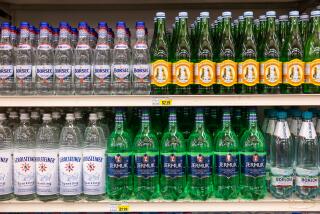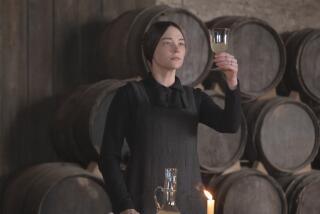Cabernets Ride the Crest on a Third Wave of Labeling
Cabernet Sauvignon once was California’s best red wine. Soon it may be relegated to No. 2. And the new king of the hill will be a new concept in wine marketing, one that focuses on super-premium proprietary wines.
The first sign of this popped up in the mid-1970s, and today the idea is taking hold throughout California. And until we’re all comfortable with the concept, this trend is sure to lead to plenty of confusion.
This is California’s third wave in wine designations. The first phase came when wine quality wasn’t a major concern; the second happened when interest in quality wine rapidly increased. Today, high quality is everything and the image that sells is not varietal as much as proprietary.
Fifty years ago, almost every wine sold in this country was generic. The name of the grape variety rarely was used on a label, and even then there was no guarantee the wine would taste like that variety.
Generic Wines Ruled
Some famed wineries like Beaulieu, Inglenook, Martini and Krug used varietal designations, but they were in the minority. Generic wines ruled. Most wines carried the names of French, German or even Italian wine districts, like Burgundy, Rhine and Chianti. The wines themselves, however, had little relation stylistically to the wines of those regions.
Lou Foppiano tells the story of his family winery’s practice back in the 1940s of selling two wines, one called Chablis and the other called Sauterne (without the terminal s of the French district).
“Both wines came out of the same tank,” said Foppiano. “But we sold 10 times more Sauterne than we did Chablis.”
During the 1940s, varietal wines listing the name of the grape began to be used as a mark of premium quality. The late wine merchant Frank Schoonmaker championed varietal labels and soon blended, generic wine took on the image of poor quality. The implication was that if a wine was 100% of one variety, and so named, it had to be better wine than one blended from a melange of grapes, some good and some not so good.
In those days, a wine could be labeled as a varietal wine if it contained 51% of the named variety. But that permitted so much blending that about 10 years ago, the rule was changed to a 75% minimum.
The first hint of the third wave in wine marketing came with the release in 1977 of the 1974 Joseph Phelps Insignia, a wine that did not carry a varietal designation, but carried a high price tag. The idea was to avoid being hamstrung by the 75% minimum law. Phelps wanted the flexibility to blend in any percentage of the classical Bordeaux varieties to make a Bordeaux-styled wine. He wanted to keep open his options in case one grape variety failed to ripen fully in a vintage. The “premium proprietary” designation would permit him to blend to make a better wine.
Others adopted premium proprietary designations and by 1979 the concept was certified as a trend when the Robert Mondavi Winery and the late Baron Philippe de Rothschild formed a joint venture to make a California wine along the lines of the baron’s Chateau Mouton-Rothschild. The wine was later named Opus One. Price was set at $50 a bottle.
Today at least a dozen wineries make a premium proprietary wine. Most of them are excellent, the major differences being the blend of grapes used. (Another trend now developing is the greater use of Cabernet Franc as a blending grape to expand the capabilities of the Cabernet Sauvignon. The popularity of Merlot as a varietal wine has made it expensive to use to improve the quality of Cabernet Sauvignon.)
Some Steep Prices
I recently tasted a number of premium proprietary wines and liked them, but prices are steep and I’m not sure these wines are that much better than the top Cabernet Sauvignons that sell for less. Here are tasting notes of the top wines from my notebook, in order of my preference:
--1984 Reserve Alexandre (Geyser Peak, $18): The best wine I have tasted from this long-time Sonoma producer. Raspberry and red currant flavors are enhanced by lovely nuances of new French oak. A lean, finely tuned aftertaste indicates a long life. (The blend contains 3% of Malbec, a rarely used Bordeaux variety.)
--1984 Opus One (Mondavi, $55): A load of very toasty new French oak enhances the currant and cherry fruit to give you a very round, ripe sensation. However, a slug of tannin at the end makes the wine a bit hard. Give it time, though, and it should soften.
--1984 Trilogy (Flora Springs, $35): A wine of more finesse and grace than power. Delicate cherrylike fruit combines with slight pipe tobacco and spice character. A slightly hard finish is not bothersome.
--1984 Marlstone (Clos du Bois, $22.50): Complete wine, quite approachable with rich, ripe fruit, oak flavors and soft, almost sweet finish. The best Marlstone to date, but a wine I wouldn’t age excessively (three more years perhaps). Marlstone is the name of a vineyard, but has been used as a proprietary designation since 1978.
--1985 The Poet (Cosentino, $18): Red currants, new oak (with a roasted nut-tobacco note) and spice lend intrigue. Very attractive wine with slight hardness in the finish that will age out within two years. The blend has 29% Cabernet Franc.
--1985 Bouchet (Brander, $12): Slightly herbal in tone, but with ample fruit and much complexity. The rich finish is appealing; so is the price. This wine is 50% Cabernet Franc, 50% Merlot.
--1984 Insignia (Phelps, $35): Intensely rich, potent aroma of anise, blackberry and oak leads to a huge panoply of tastes. There is a load of tannin (typical of Insignia), meaning it will have to age a long time before it smooths out.
--1983 Meilleur du Chai (Rombauer, $30): Herbal and oaky, but with dense fruit and fullness on the palate. Rough tannins in the aftertaste should drop in time.
There are others on the market that have been much less impressive. The following wines are all less than $20: 1985 Cuvee Bellrose (relatively jammy-overripe aromas and fairly simple flavors plus a load of tannin); 1985 Ventana Magnus (weedy, green bean smells and a very soft, clumsy aftertaste); 1984 Dry Creek Reserve (not much fruit with a slightly dank undertone and a sweetish finish).
This Year’s Most Famous
The most confusing of the premium proprietary wines is also the most famous of the year. It is 1984 Dominus ($40), introduced in March, a joint project of Christian Moueix of Chateau Petrus and the daughters of the late John Daniel, owner of Inglenook. The wine is a total mystery to me.
I have had it five times. Once it was excellent. That was at its preview tasting in San Francisco, when Moueix unveiled it. Another time, a bottle I had at a restaurant with dinner was good, but not great.
The other three times (twice in wine competitions and the third time in a blind tasting) the wine appeared to have a spoilage problem. Moreover, in both wine competitions, a number of other judges confirmed my suspicions.
The problem we felt we detected is called brettanomyces (called bret by those in the industry). It is a bacterial spoilage and it smells like a wet horse blanket, or a wet dog. And when it is faint, it can actually add a note of complexity that some people like in Cabernet Sauvignon-type wines.
In the case of the Dominus, on the three occasions when I detected what I felt was bret, the aroma was stronger that just a note of complexity.
To date, premium proprietary designations have been used largely on Bordeaux-styled red wines, though a few Bordeaux-styled white wines, blends of Sauvignon Blanc and Semillon, are beginning to be seen. No one makes a blended Chardonnay, but we may soon be seeing premium Rhone-type blended wines similar to Bonny Doon’s Le Cigare Volant.
For now, be prepared to see more wines with names you haven’t heard of. It is the trend of the 1990s.
Note of amusement: I stopped at a gift shop at L.A. International Airport the other day and, browsing, I discovered for sale a two-bottle pack of wines selling for $9.99. The wines were 1984 Zaca Mesa Blanc de Noirs and 1983 Zaca Mesa Sauvignon Blanc, both of which are probably over the hill.
And there was a 1985 Parsons Creek Riesling with a sign that said, “Originally $10, now $4.99.” The wine never sold for more than $7, at most, when it was fresh and interesting.
That wasn’t all. Under the “California Memories” sign were such things as Mesa Verde Pottery from Colorado, a coin purse with Indian symbols on it made in China, and a “California Blue” coffee mug made in Korea. So much for truth in advertising.
Wine of the Week: 1986 Louis Honig Sauvignon Blanc ($8.25)--This winery, owned by California Superintendent of Public Instruction William Honig and his family, has made only Sauvignon Blanc to date, though Cabernet Sauvignon and Chardonnay are being added to the line. This wine, wine maker James Hall’s first effort, is perfectly balanced--slightly green / herbal but with a lovely melony fruit quality.
More to Read
Eat your way across L.A.
Get our weekly Tasting Notes newsletter for reviews, news and more.
You may occasionally receive promotional content from the Los Angeles Times.










